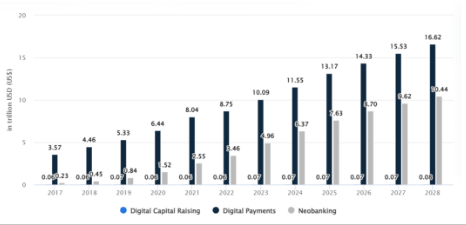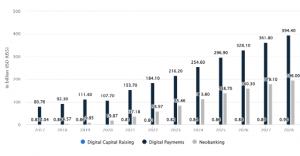Running errands at the bazaar (mandi) is a breeze now. No more struggling with overflowing wallets and loose change. Just whip out your phone, open a UPI app, and pay! It’s amazing to see vegetable vendors displaying a whole stack of QR codes for various UPI platforms like PhonePe and PayTM.
Hailing a ride with Uber, Ola, or even a private car or rickshaw? No problem! Skip the hassle of fumbling for exact fare. Simply open UPI, enter the amount, and you’re good to go. This ease of payment extends to nearly every shop – groceries, clothes, stationery, restaurants, even the street carts selling vegetables and trinkets. This, my friend, is a full-fledged fintech revolution!
This edition of “The People Weekly” will delve deep into the fintech ecosystem of India. Driven by a commitment to keeping its readers informed and ahead of the curve, PeopleLogic relentlessly strives to deliver the latest industry news and trends through its insightful newsletter, “The People Weekly”.
Fintech Evolution and Revolution
As the name suggests, fintech is the combination of two words “Financial” and “Technology”. It simply means using technology in financial services. Started as a way to improve the different processes involved in traditional financial services, fintech later evolved into something more deeper and vast. While fintech might seem like a recent invention, its roots go much deeper. Early innovations like Fedwire for electronic fund transfers, universal credit cards, ATMs, and digital banking platforms all paved the way for the modern fintech ecosystem.
The decade between 2008 and 2019 witnessed a surge in fintech services. The COVID-19 pandemic further accelerated this growth, propelling fintech into a disruptive force that is reshaping the financial landscape.
Fintech Revolution -Growth – Global
The fintech sector globally is growing at a CAGR of 16.5% and to reach USD 1,152.06 billion by 2032. Currently the global fintech market is valued at USD 294.74 billion in 2023. A Mckinsey research shows that revenues in the fintech industry are expected to grow almost three times faster than those in the traditional banking sector between 2023 and 2028. As per the research, the fintech industry will register a revenue growth of 15% in the next five years as compared to the 6% registered by traditional banks.


Fintech Revolution- Growth – India
The Indian fintech industry has logged in an impressive 59% in Q1 2024, as per Tracxn. As for funding, there was a slowdown by 57%. Despite that, the Indian fintech industry stood third in terms of funding, behind US and China. The Indian fintech industry’s Total Addressable Market is estimated to be $1.3 Tn by 2025 and Assets Under Management & Revenue to be $1 Tn and $200 Bn by 2030, respectively. By 2025, the market size is expected to reach USD 150 billion.
- India accounted for 46% of all real time transactions.
- There are around 3085 DPIIT registered fintech startups (August 2023) and over 9000 fintech companies
- The digital payment market users is expected to amount to 837.20m users by 2028.
- India has produced 17 unicornsin the fintech space
- The UPI transactions witnessed an annual growth of 82% in FY ‘24, reaching a total of 38.87 billion transactions.

Major Growth Drivers
- High Smartphone and Internet Penetration: India boasts a massive young population with a high number of smartphone users and internet subscribers.
- Government Initiatives: The Indian government actively pushes for digitalization and financial inclusion. This includes initiatives like Aadhaar, UPI, and Bharat Bill Payments, which create a robust digital infrastructure for fintech companies to leverage.
- Technological Innovation: Fintech companies in India are embracing cutting-edge technologies like Artificial Intelligence, Blockchain, and cloud-based solutions to create efficient and secure financial products.
- Collaboration with traditional banks : Fintech startups are actively collaborating with traditional banks thus fuelling the growth of the sector.
- Favorable Demographics: India has a young and growing working population, a demographic that is typically more receptive to new financial technologies.
- JAM Trinity: Jan Dhan Yojana, Aadhar and Mobile connectivity
Segments in Fintech
The Indian Fintech industry is a vibrant ecosystem with several key segments, each catering to specific financial needs. Here’s a breakdown of the major ones
- Digital Payments: This is the powerhouse driving the cashless economy. It encompasses mobile wallets, UPI (Unified Payments Interface) transactions, online payment gateways, and digital point-of-sale systems.
- Digital Lending: Fintech companies are making access to credit easier, particularly for individuals and small businesses underserved by traditional banks. This segment includes peer-to-peer lending platforms, micro-lending solutions, and online loan marketplaces.
- InsurTech: This segment uses technology to revolutionize the insurance sector. InsurTech companies offer features like online policy purchase, automated claims processing, and customized insurance products.
- WealthTech: WealthTech platforms empower individuals with tools for managing their investments. They offer robo-advisors for automated investment management, digital brokerage services, and fractional share investing.
- RegTech: Focuses on using technology to streamline compliance processes for financial institutions.
- Neo-banking: These are entirely digital banks offering a full suite of financial services without a physical branch network.
- Blockchain: This technology has the potential to revolutionize financial transactions with increased security and transparency.

Future Trends in Fintech
Fintech industry is a dynamic ecosystem constantly pushing the boundaries of financial services. Here’s a glimpse into some of the key trends shaping its future.
- Decentralized Finance (DeFi) and Blockchain: DeFi, which uses blockchain technology to facilitate peer-to-peer financial transactions without intermediaries, is poised for significant growth
- B2B2X and b2b : While the last decade saw payments, the future of fintech will be lead by B2B2X and B2b(small businesses) . B2B2X comprises ,B2B2C(enabling other players to serve customers better) and B2B2B(enabling other players to better serve other businesses). The B2B2X market is expected to grow at a 25% CAGR to reach $440 billion in annual revenues by 2030, supported by growth in embedded finance and financial infrastructure; while the B2b fintech market is expected to grow at a 32% CAGR to reach $285 billion in annual revenue by providing solutions to credit-starved and poorly served small businesses.
- Embedded Finance: Integrating financial services seamlessly into non-financial platforms like ride-hailing apps or social media is a growing trend.
- Open Banking: Open APIs will facilitate collaboration between Fintech startups and traditional institutions, fostering a more interconnected and competitive financial ecosystem.
- Rise of the Neobanks: Fully digital banks with no physical branches are expected to gain traction in India, offering a convenient and cost-effective alternative to traditional banks.
- RegTech: RegTech startups are developing solutions to streamline compliance processes and mitigate risks. India’s focus on building a robust RegTech ecosystem will be key to fostering responsible innovation.
- Focus on SME markets : Fintech companies will focus more on SMEs by offering them a range of solutions like alternative lending, cash flow management, embedded financial tolls thus helping them grow and expand.
Fintech and Job Creation
India’s booming fintech industry is creating a wave of new career opportunities. While new roles like blockchain specialists, AI analysts for fraud detection, and cybersecurity experts for digital payments are created, traditional roles are also getting redefined. Existing roles in banking, accounting, and wealth management are evolving to incorporate fintech tools and processes.
Some of the roles across sectors are
Tech: Software developers, data scientists, and product managers are needed to build and maintain complex fintech platforms.
Non-Tech: Roles in sales, marketing, customer support, and legal departments are crucial for fintech companies to function effectively.
The surge in funding and investor interest is fueling the growth of Fintech startups. These young companies typically have agile work cultures and require a diverse range of professionals, creating a dynamic job market.
Given the dynamic nature of this sector, traditional financial skills might not be enough.Upskilling and continuous learning will be crucial for existing workers to stay relevant.
PeopleLogic Opinion
India’s Fintech revolution is rapidly transforming the financial landscape, creating a wealth of new opportunities for both businesses and individuals.As the industry matures, addressing the challenges of skill development and talent acquisition will be crucial to sustaining this growth.
With a focus on digital payments, lending, wealthtech, and InsurTech, the industry demands a unique blend of financial knowledge and technological expertise. This creates exciting opportunities for professionals across domains – from software developers and data scientists to financial advisors and UI/UX designers. As Fintech continues to disrupt the financial landscape, upskilling and embracing new technologies will be key for individuals to thrive in this dynamic ecosystem.
By providing talent solutions tailored to the Fintech industry, Peoplelogic has a proven track record of connecting qualified professionals – from software developers to wealth management specialists – with exciting Fintech opportunities. Our expertise and experience positions us to deliver exceptional talent solutions for your company, ensuring you have the right people in place to propel your Fintech business forward.






